The Importance of Water and Climate-Related Aspects in the Quality of Urban Life Assessment
Abstract
1. Introduction
2. Materials and Methods
3. Results
3.1. Integrating Water and Climate-Related Aspects in the QoL Assessment Tools
3.1.1. Importance of Water-Related Aspects in the Analyzed Tools
3.1.2. Importance of Climate-Related Aspects in the Analyzed Tools
3.2. Comparison of the Indicators Related to Water and Climate Aspects
3.2.1. Water-Related Indicators in the Analyzed QoL Assessment Tools
- -
- Water quality (2.3); and
- -
- Water pollution (2.4).
- -
- Quality of water provision (2.1);
- -
- Water potability (2.2);
- -
- Quality of tap water (2.3); and
- -
- Drinking water quality (2.4).
- -
- Sewage (2.2, 2.14);
- -
- Sanitary facilities (2.8, 2.10, 2.11); and
- -
- Sanitary conditions (2.6, 3.1).
3.2.2. Climate-Related Indicators in the Analyzed QoL Assessment Tools
- -
- Air pollution/quality (2.2, 2.4, 2.6, 2.7, 2.9, 2.10, 2.11, 2.12, 2.14, 2.15, 3.1, 3.4);
- -
- Humidity/temperature (2.1, 2.3, 2.4);
- -
- Hours of sunshine (2.3);
- -
- Weather (2.7); which was assessed as a composite score using heating degree days, cooling degree days, humidity, sunshine, and precipitation.
- -
- Discomfort of climate to travellers (2.1);
- -
- Carbon neutral (2.3);
- -
- CO2 Emmission Index (2.4); and
- -
- Climate (2.2); which was explained using the example of characteristics of the Four Seasons.
- -
- Environmental initiatives, walkable, and environmentally friendly in Monocle’s Quality of Living Survey (2.3);
- -
- Perception of pollution, grime, or other environmental problems in Quality of life (well-being of Europeans) (2.9);
- -
- Recycling rate and renewable energy in How’s Life? 2020 Measuring Well-being (2.11);
- -
- City is committed to fight against climate change (2.12);
- -
- City expenditure on air and climate protection (2.14).
3.2.3. Additional Indicators Related to Green Infrastructure in the Analyzed QoL Assessment Tools
- -
- Green spaces which were not specified (2.15), amount/number of green spaces, parks, gardens, and so on (2.3, 2.12, 2.14, 3.4), and natural and semi-natural land cover (2.11);
- -
- Intact forest landscape and protected areas (terrestial and marine) (2.11);
- -
- Red List Index (threatened species) (2.11); and
- -
- Soil nutrient balance (2.11).
3.3. Comparison of the Top Cities in the Most Comprehensive International QoL Rankings with the Results of the Sustainability and Resilience (S&R) Rankings
4. Findings and Discussion
4.1. The Relationship between Water and Climate Aspects and Domains of the Quality of Urban Life
4.2. The Most Comprehensive QoL Assessment Tools Including Water and Climate Aspects
4.3. Comparison of the International and Polish QoL Assessment Tools
4.4. Indicators Used in QoL Assessment Tools
4.5. Comparison of the Winning Cities in QoL and S&R Rankings
5. Conclusions
Author Contributions
Funding
Institutional Review Board Statement
Data Availability Statement
Conflicts of Interest
References
- World Bank Group; Freire, M.; Lee, M.J.; Lee, M.J.; Bhada-Tata, P. Cities and Climate Change: Responding to an Urgent Agenda; World Bank Publications: Herndon, VA, USA, 2011; ISBN 978-0-8213-8667-5. [Google Scholar]
- United Nations. The Sustainable Development Goals Report 2019; UN: New York, NY, USA, 2019. [Google Scholar] [CrossRef]
- Lowe, M.; Whitzman, C.; Badland, H.; Davern, M.; Aye, L.; Hes, D.; Butterworth, I.; Giles-Corti, B. Planning Healthy, Liveable and Sustainable Cities: How Can Indicators Inform Policy? Urban Policy Res. 2015, 33, 131–144. [Google Scholar] [CrossRef]
- Gawlak, A.; Matuszewska, M.; Ptak, A. Inclusiveness of Urban Space and Tools for the Assessment of the Quality of Urban Life—A Critical Approach. Int. J. Environ. Res. Public Health 2021, 18, 4519. [Google Scholar] [CrossRef]
- Mittal, S.; Chadchan, J.; Mishra, S.K. Review of Concepts, Tools and Indices for the Assessment of Urban Quality of Life. Soc. Indic. Res. 2020, 149, 187–214. [Google Scholar] [CrossRef]
- World Urbanization Prospects: The 2018 Revision, Custom Data Acquired via Website; United Nations. Department of Economic and Social Affairs, Population Division: New York, NY, USA, 2018; Available online: https://population.un.org/wup/DataQuery/ (accessed on 28 April 2021).
- Statistics on European Cities; Eurostat: Luxembourg. 2019. Available online: https://ec.europa.eu/eurostat/statistics-explained/index.php/Statistics_on_European_cities#Population (accessed on 23 April 2021).
- Temelová, J.; Dvořáková, N. Residential Satisfaction of Elderly in the City Centre: The Case of Revitalizing Neighbourhoods in Prague. Cities 2012, 29, 310–317. [Google Scholar] [CrossRef]
- Chong, K.H.; To, K.; Fischer, M.M. Dense and Ageing: Social Sustainability of Public Places amidst High-Density Development. Grow. Compact. Urban Density Sustain. 2017. [Google Scholar] [CrossRef]
- Jancz, A.; Trojanek, R. Housing Preferences of Seniors and Pre-Senior Citizens in Poland—A Case Study. Sustainability 2020, 12, 4599. [Google Scholar] [CrossRef]
- GHO|By Category|Life Expectancy and Healthy Life Expectancy-Data by Country. Available online: https://apps.who.int/gho/data/node.main.688 (accessed on 19 May 2021).
- Gandini, A.; Garmendia, L.; San-Mateos, R. Towards sustainable historic cities: Adaptation to climate change risks. Entrep. Sustain. Issues 2017, 4, 319–327. [Google Scholar] [CrossRef]
- Dastgerdi, A.S.; Sargolini, M.; Pierantoni, I. Climate Change Challenges to Existing Cultural Heritage Policy. Sustainability 2019, 11, 5227. [Google Scholar] [CrossRef]
- Yang, H.; Lee, T.; Juhola, S. The Old and the Climate Adaptation: Climate Justice, Risks, and Urban Adaptation Plan. Sustain. Cities Soc. 2021, 67, 102755. [Google Scholar] [CrossRef]
- Leyva, E.W.A.; Beaman, A.; Davidson, P.M. Health Impact of Climate Change in Older People: An Integrative Review and Implications for Nursing. J. Nurs. Scholarsh. 2017, 49, 670–678. [Google Scholar] [CrossRef] [PubMed]
- Revi, A.; Satterthwaite, D.E.; Aragón-Durand, F.; Corfee-Morlot, J.; Kiunsi, R.B.R.; Pelling, M.; Roberts, D.C.; Solecki, W. Urban areas. In Climate Change 2014: Impacts, Adaptation, and Vulnerability. Part A: Global and Sectoral Aspects. Contribution of Working Group II to the Fifth Assessment Report of the Intergovernmental Panel on Climate Change; Field, C.B., Barros, V.R., Dokken, D.J., Mach, K.J., Mastrandrea, M.D., Bilir, T.E., Chatterjee, M., Ebi, K.L., Estrada, Y.O., Genova, R.C., et al., Eds.; Cambridge University Press: Cambridge, UK; New York, NY, USA, 2014; pp. 535–612. [Google Scholar] [CrossRef]
- World Economic Forum. The Global Risks Report 2021. Insight Report; World Economic Forum: Cologny/Geneva, Switzerland, 2021. [Google Scholar]
- Global Warming of 1.5 °C. An IPCC Special Report on the Impacts of Global Warming of 1.5°C above Pre-Industrial Levels and Related Global Greenhouse Gas Emission Pathways, in the Context of Strengthening the Global Response to the Threat of Climate Change, Sustainable Development, and Efforts to Eradicate Poverty; IPPC: Rome, Italy, 2019; Available online: https://www.ipcc.ch/sr15/ (accessed on 22 April 2021).
- Rosenzweig, C.; Solecki, W.D.; Hammer, S.A.; Mehrotra, S. Climate Change and Cities: First Assessment Report of the Urban Climate Change Research Network; Cambridge University Press: Cambridge, UK, 2011; Available online: https://books.google.pl/books?hl=en&lr=&id=9GHW24KCuBYC&oi=fnd&pg=PR7&dq=climate+change+impact+on+seniors%27+quality+of+life+and+cities++&ots=_4rBX1v_MC&sig=ZrrYpvXBrrvRfMlRffRmnyKlpbg&redir_esc=y#v=onepage&q=climate%20change%20impact%20on%20seniors’%20quality%20of%20life%20and%20cities&f=false (accessed on 23 April 2021).
- Benevolenza, M.A.; DeRigne, L. The impact of climate change and natural disasters on vulnerable populations: A systematic review of literature. J. Hum. Behav. Soc. Environ. 2019, 29, 266–281. [Google Scholar] [CrossRef]
- Hoornweg, D.; Sugar, L.; Lorena Trejos Gomez, C. in press; Cities and Greenhouse Gas Emissions: Challenges and Opportunities. Environ. Urban. 2011, 23, 207–227. [Google Scholar] [CrossRef]
- Mbow, H.-O.P.; Reisinger, A.; Canadell, J.; O’Brien, P. Special Report on Climate Change, Desertification, Land Degradation, Sustainable Land Management, Food Security, and Greenhouse Gas Fluxes in Terrestrial Ecosystems (SR2); IPCC: Geneva, Switzerland, 2017; Available online: https://www.ipcc.ch/report/srccl/ (accessed on 10 August 2020).
- Liang, L.; Deng, X.; Wang, P.; Wang, Z.; Wang, L. Assessment of the Impact of Climate Change on Cities Livability in China. Sci. Total Environ. 2020, 726, 138339. [Google Scholar] [CrossRef]
- Hunt, A.; Watkiss, P. Climate Change Impacts and Adaptation in Cities: A Review of the Literature. Clim. Chang. 2011, 104, 13–49. [Google Scholar] [CrossRef]
- Megarry, W. Future of Our Pasts: Engaging Cultural Heritage in Climate Action: Report of the ICOMOS Workings Group on Climate Change and Cultural Heritage; ICOMOS: Paris, France, 2019; Available online: https://adobeindd.com/view/publications/a9a551e3-3b23-4127-99fd-a7a80d91a29e/g18m/publication-web-resources/pdf/CCHWG_final_print.pdf (accessed on 19 May 2021).
- The United Nations World Water Development Report 2021: Valuing Water; UNESCO: Paris, France, 2021. Available online: http://www.unesco.org/reports/wwdr/2021/en/download-the-report (accessed on 23 March 2021).
- The 17 GOALS|Sustainable Development. Available online: https://sdgs.un.org/goals (accessed on 19 May 2021).
- Grellier, J.; White, M.P.; Albin, M.; Bell, S.; Elliott, L.R.; Gascón, M.; Gualdi, S.; Mancini, L.; Nieuwenhuijsen, M.J.; Sarigiannis, D.A.; et al. BlueHealth: A Study Programme Protocol for Mapping and Quantifying the Potential Benefits to Public Health and Well-Being from Europe’s Blue Spaces. BMJ Open 2017, 7, e016188. [Google Scholar] [CrossRef]
- The IWA Principles for Water Wise Cities, 2nd ed.; IWA: London, UK, 2016; Available online: https://iwa-network.org/publications/the-iwa-principles-for-water-wise-cities/ (accessed on 19 May 2021).
- Arcadis. Sustainable Cities Water Index: Which Cities Are Best. Placed to Harness Water for Future Success; Arcadis: Amsterdam, The Netherlands, 2016; Available online: https://www.arcadis.com/en/global/our-perspectives/which-cities-are-best-placed-to-harness-water-for-future-success-/ (accessed on 23 April 2021).
- Roberts, W.O. Climate Change and the Quality of Life for the Earth’s New Millions. Proc. Am. Philos. Soc. 1976, 120, 230–232. Available online: https://www.jstor.org/stable/986562 (accessed on 23 April 2021).
- Estoque, R.C.; Togawa, T.; Ooba, M.; Gomi, K.; Nakamura, S.; Hijioka, Y.; Kameyama, Y. A Review of Quality of Life (QOL) Assessments and Indicators: Towards a “QOL-Climate” Assessment Framework. Ambio 2019, 48, 619–638. [Google Scholar] [CrossRef] [PubMed]
- Newton, P.W. Liveable and Sustainable? Socio-Technical Challenges for Twenty-First-Century Cities. J. Urban Technol. 2012, 19, 81–102. [Google Scholar] [CrossRef]
- China Council for International Cooperation on Environment and Development and WWF. Report on Ecological Footprint in China; China Council for International Cooperation on Environment and Development and WWF: Beijing, China, 2008.
- Jones, C.; Newsome, D. Perth (Australia) as One of the World’s Most Liveable Cities: A Perspective on Society, Sustainability and environment. Int. J. Tour. Cities 2015, 1, 18–35. [Google Scholar] [CrossRef]
- Global Age-Friendly Cities: A Guide; World Health Organization: Geneva, Switzerland, 2007; Available online: https://www.who.int/ageing/publications/Global_age_friendly_cities_Guide_English.pdf (accessed on 23 April 2021).
- Van der Weijst, L. Measuring the Age-Friendliness of Cities: A Guide to Using Core Indicators; WHO: Kobe, Japan, 2015; Available online: https://www.who.int/ageing/age_friendly_cities_guide/en/ (accessed on 23 April 2021).
- Seniors, F.M.R. Age-Friendly Rural and Remote Communities: A Guide; Federal/Provincial/Territorial Ministers Responsible for Seniors: Toronto, ON, CA, 2007; Available online: https://www.phac-aspc.gc.ca/seniors-aines/alt-formats/pdf/publications/public/healthy-sante/age_friendly_rural/AFRRC_en.pdf (accessed on 23 April 2021).
- Błędowski, P.; Szatur-Jaworska, B.; Bakalarczyk, R.; Łuczak, P.; Szweda-Lewandowska, Z.; Zrałek, M.; Plak, J.; Zubrzycka-Czarnecka, A. System Wsparcia Osób Starszych w Środowisku Zamieszkania: Przegląd Sytuacji, Propozycja Modelu (System of Support for the Elderly in the Living Environment-Overview of the Situation, Model Proposal. Synthesis); Biuro Rzecznika Praw Obywatelskich: Warsaw, Poland, 2016; ISBN 978-83-65029-19-5. [Google Scholar]
- The Global Liveability Index 2019; The Economist Intelligence Unit: London, UK, 2019; Available online: https://www.eiu.com/public/topical_report.aspx?campaignid=liveability2019 (accessed on 23 April 2021).
- Mercer. Quality of Living-Location Reports. Available online: https://mobilityexchange.mercer.com/Insights/quality-of-living-rankings (accessed on 23 April 2021).
- Monocle. Quality of Life Survey. Monocle 2019, 13, 41–65. Available online: https://monocle.com/magazine/issues/125/quality-of-life-survey/ (accessed on 23 April 2021).
- Reid, J.; Nicol, C.; Allen, H. Mapping the World’s Prices 2019. Thematic Research; Deutsche Bank AG: London, UK, 2019; Available online: https://www.dbresearch.com/PROD/RPS_EN-PROD/PROD0000000000494405/Mapping_the_world%27s_prices_2019.pdf?undefined&realload=F2~IVP2mCVDyfT99gzd7uKrqddmpspNMhF8BAP9Ave1vRpxfiznJaIQdrVH3WOK73x~GZGNgCWzIHs~wiDkeQw== (accessed on 23 April 2021).
- Björnberg, A.; Phang, A.Y. Euro Health Consumer Index 2018; Health Consumer Powerhouse: Marseillan, France, 2019; Available online: https://healthpowerhouse.com/publications/ (accessed on 23 April 2021).
- IMD World Competitiveness Center’s Smart City Observatory, Singapore University of Technology and Design. IMD Smart City Index; The IMD World Competitiveness Center: Lausanne, France; Beach Road, Singapore, 2019; Available online: https://www.imd.org/research-knowledge/reports/imd-smart-city-index-2019/ (accessed on 23 April 2021).
- Kubendran, S.; Soll, L.; Irving, P. Best Cities for Successful Aging 2017; Milken Institute, Santa Monica, California, US 2017. Available online: https://milkeninstitute.org/reports/best-cities-successful-aging-2017 (accessed on 23 April 2021).
- Human Development Report 2019. Beyond Income, beyond Averages, beyond Today: Inequalities in Human Development in the 21st Century; UNDP: New York, NY, USA, 2019; Available online: http://hdr.undp.org/sites/default/files/hdr2019.pdf (accessed on 23 April 2021).
- Final Report of the Expert Group on Quality of Life Indicators; Publications office of the European Union, Eurostat: Luxembourg, 2017. [CrossRef]
- European Quality of Life Survey 2016: Quality of life, Quality of Public Services, and Quality of Society; Publications Office of the European Union: Luxembourg, 2017. [CrossRef]
- How’s Life? 2020: Measuring Well-Being; OECD: Paris, France, 2020; Available online: https://www.oecd-ilibrary.org/economics/how-s-life/volume-/issue-_9870c393-en (accessed on 19 May 2021).
- Quality of Life in Cities: Perception Survey in 79 European Cities; Publications Office: Luxembourg, 2013. [CrossRef]
- 2018 Active Ageing Index. Analytical Report; UNECE/European Commission: Geneva, Switzerland, 2019; Available online: https://unece.org/population/active-ageing-index (accessed on 23 April 2021).
- Polityka & Akademia Górniczo-Hutnicza. Ranking Jakości Życia. Wymiary Szczęścia (Quality of Life Ranking. Dimensions of Happiness); Polityka & Akademia Górniczo-Hutnicza: Cracow; Warsaw, Poland, 2018. [Google Scholar]
- Wałachowski, K.; Król, S. Uciekające Metropolie. Ranking 100 Polskich Miast (Runaway Metropolises. Ranking of 100 Polish Cities); Klub Jagielloński: Kraków, Polska, 2019. [Google Scholar]
- Bendowska, M.; Bieńkuńska, A.; Ciecieląg, P.; Luty, P.; Sobesjański, K.; Wójcik, J. Jakość Życia w Polsce. Edycja 2017 (Quality of Life in Poland 2017 Edition); Central Statistical Office: Warsaw, Poland, 2017. [Google Scholar]
- CBOS. Zadowolenie z Życia (Life Satisfaction); CBOS: Warsaw, Poland, 2020. [Google Scholar]
- Batorski, D.; Białowolski, P.; Czapiński, J.; Grabowska, I.; Kotowska, I.E.; Panek, T.; Pawlak, K.; Pytkowska, J.; Saczuk, K.; Strzelecki, P.; et al. Diagnoza Społeczna 2015. Warunki i Jakość Życia Polaków. Raport (Social Diagnosis 2015. Objective and Subjective Quality of Life in Poland. Report); Czapiński, J., Panek, P., Eds.; Rada Monitoringu Społecznego: Warsaw, Poland, 2015. [Google Scholar]
- Rokicka, E.; Petelewicz, M.; Woźniak, W.; Dytrych, J.; Przybylski, B.K.; Kruczkowska, P.; Drabowicz, T. Jakość Życia Mieszkańców Łodzi i Jej Przestrzenne Zróżnicowanie. (Quality of Life of Lodz Inhabitants and City’s Spatial Diversity); Rokicka, E., Ed.; Wydawnictwo Uniwersytetu Łódzkiego: Lodz, Poland, 2013. [Google Scholar]
- Jak Się Żyje Osobom Starszym w Polsce (How Is Life for the Elderly in Poland); Central Statistical Office: Warsaw, Poland, 2012. Available online: https://stat.gov.pl/obszary-tematyczne/warunki-zycia/dochody-wydatki-i-warunki-zycia-ludnosci/jak-sie-zyje-osobom-starszym-w-polsce-,8,1.html (accessed on 19 May 2021).
- Száraz, L. The Impact of Urban Green Spaces on Climate and Air Quality in Cities. Geogr. Locality Stud. 2014, 2, 326–354. [Google Scholar]
- Kozak, D.; Henderson, H.; de Castro Mazarro, A.; Rotbart, D.; Aradas, R. Blue-Green Infrastructure (BGI) in Dense Urban Watersheds. The Case of the Medrano Stream Basin (MSB) in Buenos Aires. Sustainability 2020, 12, 2163. [Google Scholar] [CrossRef]
- Hamel, P.; Tan, L. Blue–Green Infrastructure for Flood and Water Quality Management in Southeast Asia: Evidence and Knowledge Gaps. Environ. Manag. 2021, 1–20. [Google Scholar] [CrossRef]
- Citizen Centric Cities. The Sustainable Cities Index 2018; Arcadis: Amsterdam, The Netherlands, 2018; Available online: https://www.arcadis.com/en/global/our-perspectives/sustainable-cities-index-2018/citizen-centric-cities/ (accessed on 21 February 2021).
- Resilient Cities: A Grosvenor Research Report; Grosvenor: San Francisco, CA, USA, 2014; Available online: https://www.adaptationclearinghouse.org/resources/resilient-cities-a-grosvenor-research-report.html (accessed on 28 April 2021).
- Cohen, B. Global Ranking of Top 10 Resilient Cities; TriplePundit: Northampton, MA, USA, 2011; Available online: https://www.triplepundit.com/story/2011/global-ranking-top-10-resilient-cities/76411 (accessed on 28 April 2021).
- Wyzwania i Rekomendacje Dla Krajowej Polityki Miejskiej. Raport Tematycznych Grup Eksperckich Kongresu Polityki Miejskiej 2019; Kongres Polityki Miejskiej: Katowice, Poland, 2019; Available online: http://obserwatorium.miasta.pl/wp-content/uploads/2020/07/raport-wyzwania-i-rekomendacje-krajowa-polityka-miejska-Rajmund-Ry%C5%9B-Pawe%C5%82-G%C3%B3rny-Agnieszka-Sobol-Alina-Muzio%C5%82-Wec%C5%82awowicz.pdf (accessed on 19 May 2021).
- Oke, T.R. City Size and the Urban Heat Island. Atmos. Environ. 1973, 7, 769–779. [Google Scholar] [CrossRef]
- Oke, T.R.; Mills, G.; Christen, A.; Voogt, J.A. Urban Climates; Cambridge University Press: Cambridge, UK, 2017. [Google Scholar]
- Voogt, J.A.; Oke, T.R. Thermal remote sensing of urban climates. Remote Sens. Environ. 2003, 86, 370–384. [Google Scholar] [CrossRef]
- Davtalab, J.; Deyhimi, S.P.; Dessi, V.; Reza Hafezi, M.; Adib, M. The impact of green space structure on physiological equivalent temperature index in open space. Urban Clim. 2020, 31, 100574. [Google Scholar] [CrossRef]
- Fortuniak, K. Numerical estimation of the effective albedo of an urban canyon. Theor. Appl. Climatol. 2008, 91, 245–258. [Google Scholar] [CrossRef]
- Januchta-Szostak, A. River-Friendly Cities, 1st ed.; Peter Lang: Berlin, Germany; Bern, Switzerland; Bruxelles, Belgium; New York, NY, USA; Oxford, UK; Warszawa, Poland; Wien, Austria, 2020. [Google Scholar] [CrossRef]
- Krauze, K.; Wagner, I. From Classical Water-Ecosystem Theories to Nature-Based Solutions—Contextualizing Nature-Based Solutions for Sustainable City. Sci. Total Environ. 2019, 655, 697–706. [Google Scholar] [CrossRef] [PubMed]
- Kundzewicz, Z.W. Non-structural Flood Protection and Sustainability. Water Int. 2002, 27, 3–13. [Google Scholar] [CrossRef]
- Koop, S.H.A. Towards Water-Wise Cities: Global Assessment of Water Management and Governance Capacities. Ph.D. Thesis, Utrecht University, Utrecht, The Netherlands, 2019. Available online: https://dspace.library.uu.nl/handle/1874/378386 (accessed on 23 April 2021).
- Watts, N.; Amann, M.; Ayeb-Karlsson, S.; Belesova, K.; Bouley, T.; Boykoff, M.; Byass, P.; Cai, W.; Campbell-Lendrum, D.; Chambers, J. The Lancet Countdown on Health and Climate Change: From 25 Years of Inaction to a Global Transformation for Public Health. Lancet 2018, 391, 581–630. [Google Scholar] [CrossRef]
- Januchta-Szostak, A.; Banasik, K.; Chudziński, P.; Drzewiecki, S.; Hausner, J.; Jania, J.; Kundzewicz, Z.; Kutek, K.; Konieczny, R.; Licznar, P.; et al. Alert Wodny Nr 3–Woda w Miastach. Gospod. Wodna 2020, 8, 4–6. [Google Scholar]
- Sobol, A. Raport Roboczy Grupy Eksperckiej Kongresu Polityki Miejskiej Ds. Środowiska i Adaptacji Do Zmian Klimatu, Obserwato-Rium Polityki Miejskiej; IRMiR: Cracow, Poland, 2019. [Google Scholar]
- Ćmielowski, M.; Głowacki, J.; Hausner, J.; Kudłacz, M.; Kutek, K. Water City Index 2020. Ranking Efektywności Wykorzystania Zasobów Wody w Polskich Miastach; Arcadis: Amsterdam, The Netherlands, 2020; Available online: https://oees.pl/water-city-index-2020/ (accessed on 23 April 2021).
- Li, G.; Weng, Q. Measuring the Quality of Life in City of Indianapolis by Integration of Remote Sensing and Census Data. Int. J. Remote Sens. 2007, 28, 249–267. [Google Scholar] [CrossRef]
- Rao, K.R.M.; Kant, Y.; Gahlaut, N.; Roy, P.S. Assessment of Quality of Life in Uttarakhand, India Using Geospatial Techniques. Geocarto Int. 2012, 27, 315–328. [Google Scholar] [CrossRef]
- Morais, P.; Camanho, A.S. Evaluation of Performance of European Cities with the Aim to Promote Quality of Life Improvements. Omega 2011, 39, 398–409. [Google Scholar] [CrossRef]
- Estoque, R.C.; Murayama, Y. A Worldwide Country-Based Assessment of Social-Ecological Status (c. 2010) Using the Social-Ecological Status Index. Ecol. Indic. 2017, 72, 605–614. [Google Scholar] [CrossRef]
- PwC. Cities of Opportunity; PwC: London, UK, 2016. [Google Scholar]
- Lee, J.Y.; Kim, H. Projection of Future Temperature-Related Mortality Due to Climate and Demographic Changes. Environ. Int. 2016, 94, 489–494. [Google Scholar] [CrossRef]
- Labadi, S.; Giliberto, F.; Rosetti, I.; Shetabi, L.; Yildirim, E. Heritage and the Sustainable Development Goals: Policy Guidance for Heritage and Development Actors; ICOMOS: Warsaw, Poland, 2021; Volume 1, pp. 1–69. [Google Scholar]
- New European Bauhaus: Beautiful, Sustainable, Together. Available online: https://europa.eu/new-european-bauhaus/index_en (accessed on 19 May 2021).
- Bieri, D. Are Green Cities Nice Places to Live? Examining the Link between Urban Sustainability and Quality of Life. Mich. J. Sustain. 2013, 1, 44–73. [Google Scholar] [CrossRef]
- Promoting Investment for Sustainable Development in Cities; UNCTAD: Geneva, Switzerland, 2019; Available online: https://unctad.org/system/files/official-document/diaepcbinf2019d1_en.pdf (accessed on 26 May 2021).
- Marco, K.; Mihir, P.; Hannes, B. Financing Sustainable Urbanization: Counting the Costs and Closing the Gap; UN-Habitat: Nairobi, Kenya, 2020; Available online: https://unhabitat.org/sites/default/files/2020/02/financing_sustainable_urbanization_-_counting_the_costs_and_closing_the_gap_february_2020.pdf (accessed on 26 May 2021).
- 2019 Forum of the Standing Commitee on Finance: Climate Finance and Sustainable Cities; United Nations. Framework Convention on Climate Change: Bonn, Germany, 2019. Available online: https://unfccc.int/sites/default/files/resource/SCF%20Forum%202019%20report_final.pdf (accessed on 26 May 2021).
- Mochizuki, Y.; Fadeeva, Z. Competences for Sustainable Development and Sustainability: Significance and Challenges for ESD. Int. J. Sustain. High. Educ. 2010, 11, 391–403. [Google Scholar] [CrossRef]
- Paris Agreement; United Nations: Bonn, Germany, 2015. Available online: https://unfccc.int/sites/default/files/english_paris_agreement.pdf (accessed on 26 May 2021).
- Leach, J.M.; Braithwaite, P.A.; Lee, S.E.; Bouch, C.J.; Hunt, D.V.; Rogers, C.D. Measuring Urban Sustainability and Liveability Performance: The City Analysis Methodology. Int. J. Appl. Sci. Technol. 2016, 1, 86–106. [Google Scholar] [CrossRef]
- Qian, Q.K.; Ho, W.K.; Ochoa, J.J.; Chan, E.H. Does Aging-Friendly Enhance Sustainability? Evidence from Hong Kong. Sustain. Dev. 2019, 27, 657–668. [Google Scholar] [CrossRef]
- Acuto, M.; Pejic, D.; Briggs, J. Taking City Rankings Seriously: Engaging with Benchmarking Practices in Global Urbanism. Int. J. Urban Reg. Res. 2021, 45, 363–377. [Google Scholar] [CrossRef]
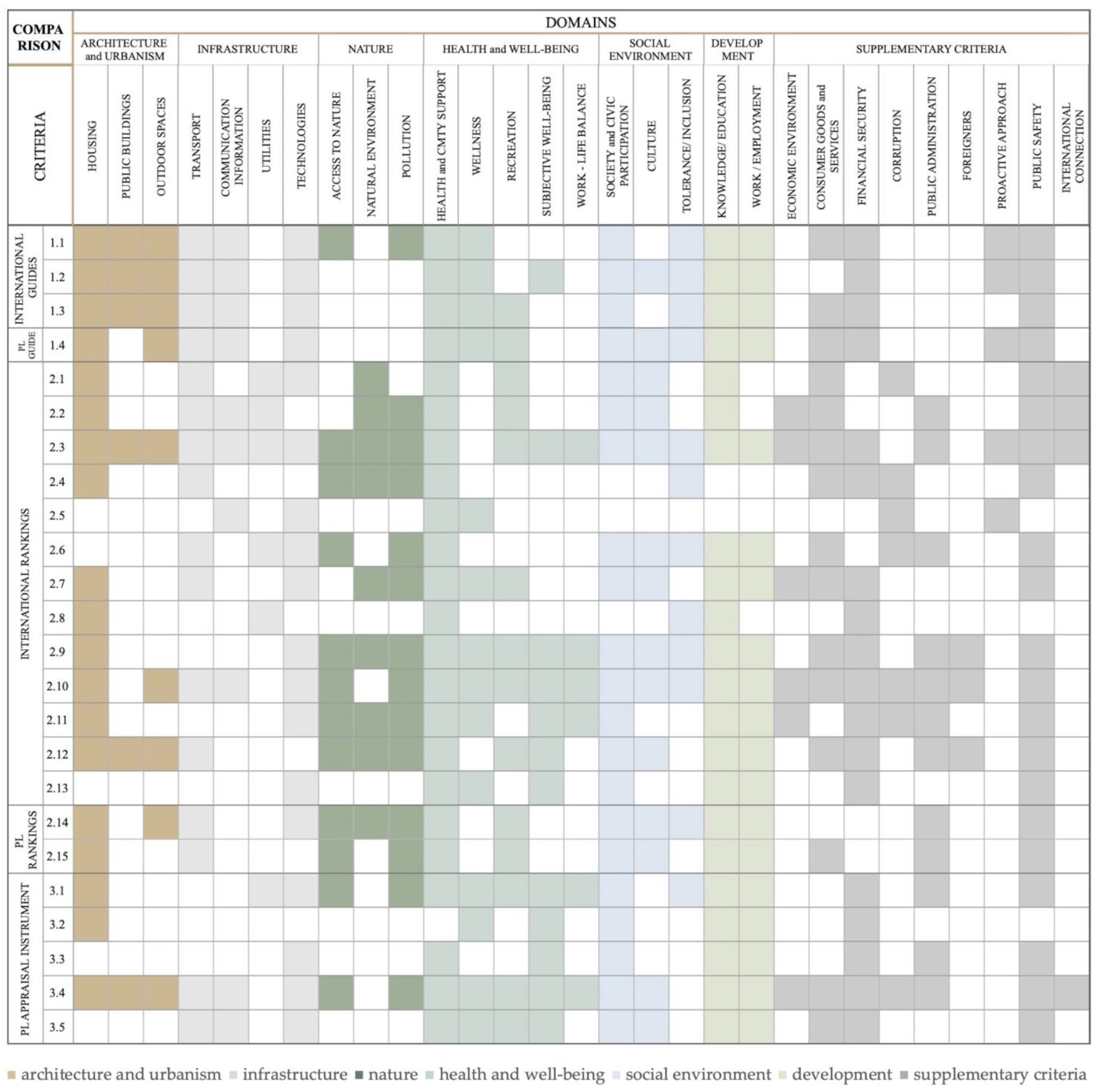

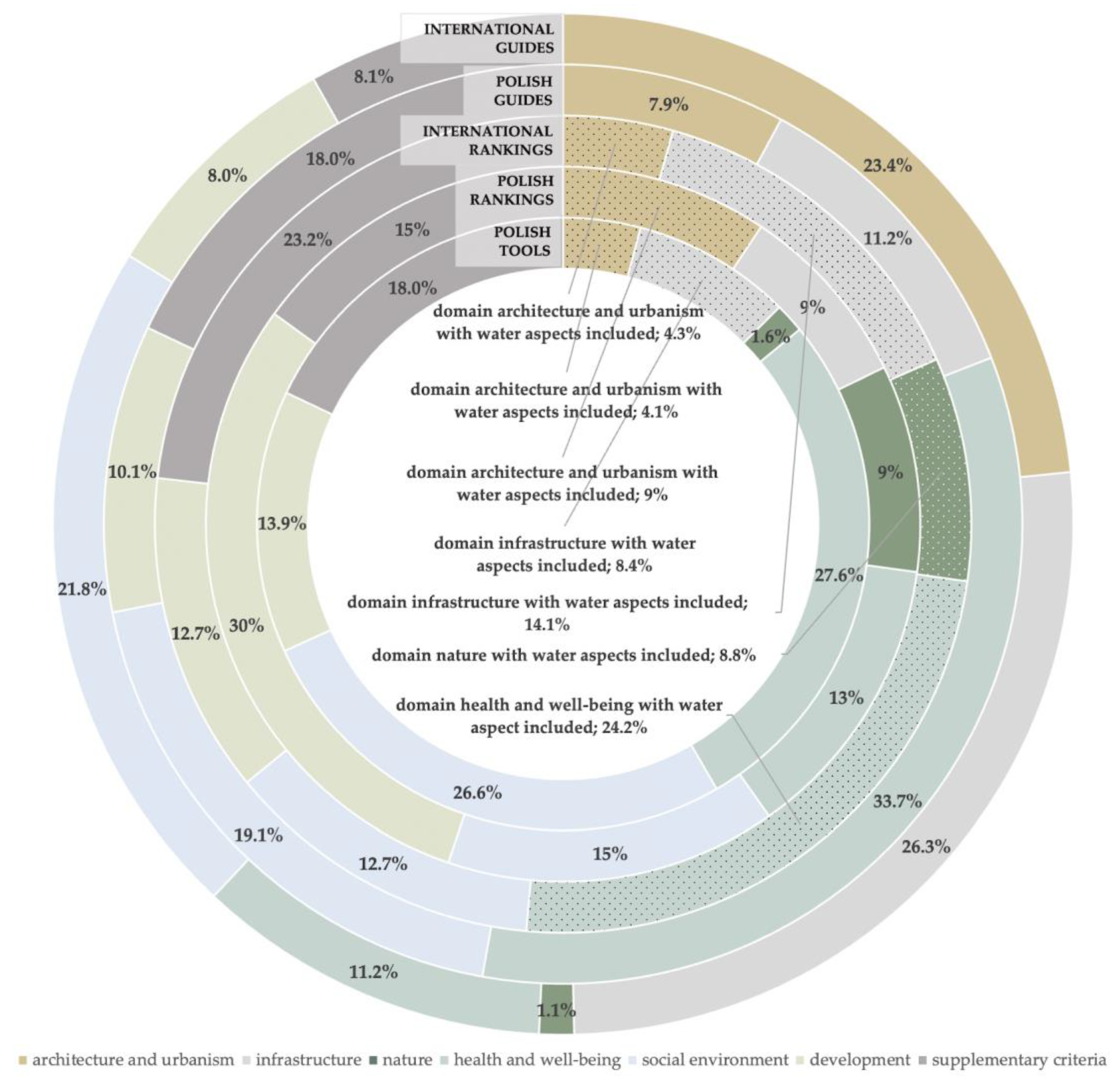

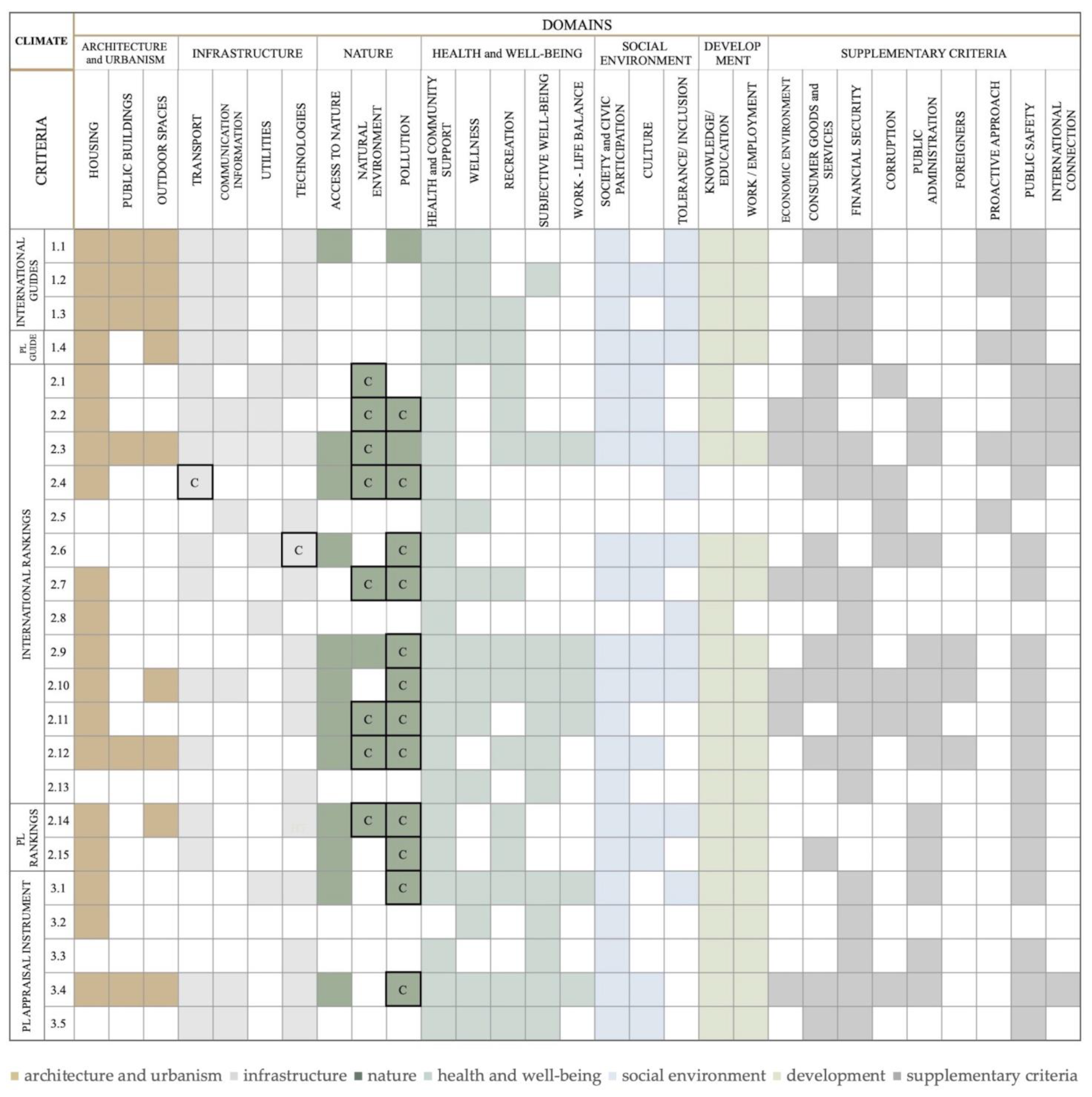

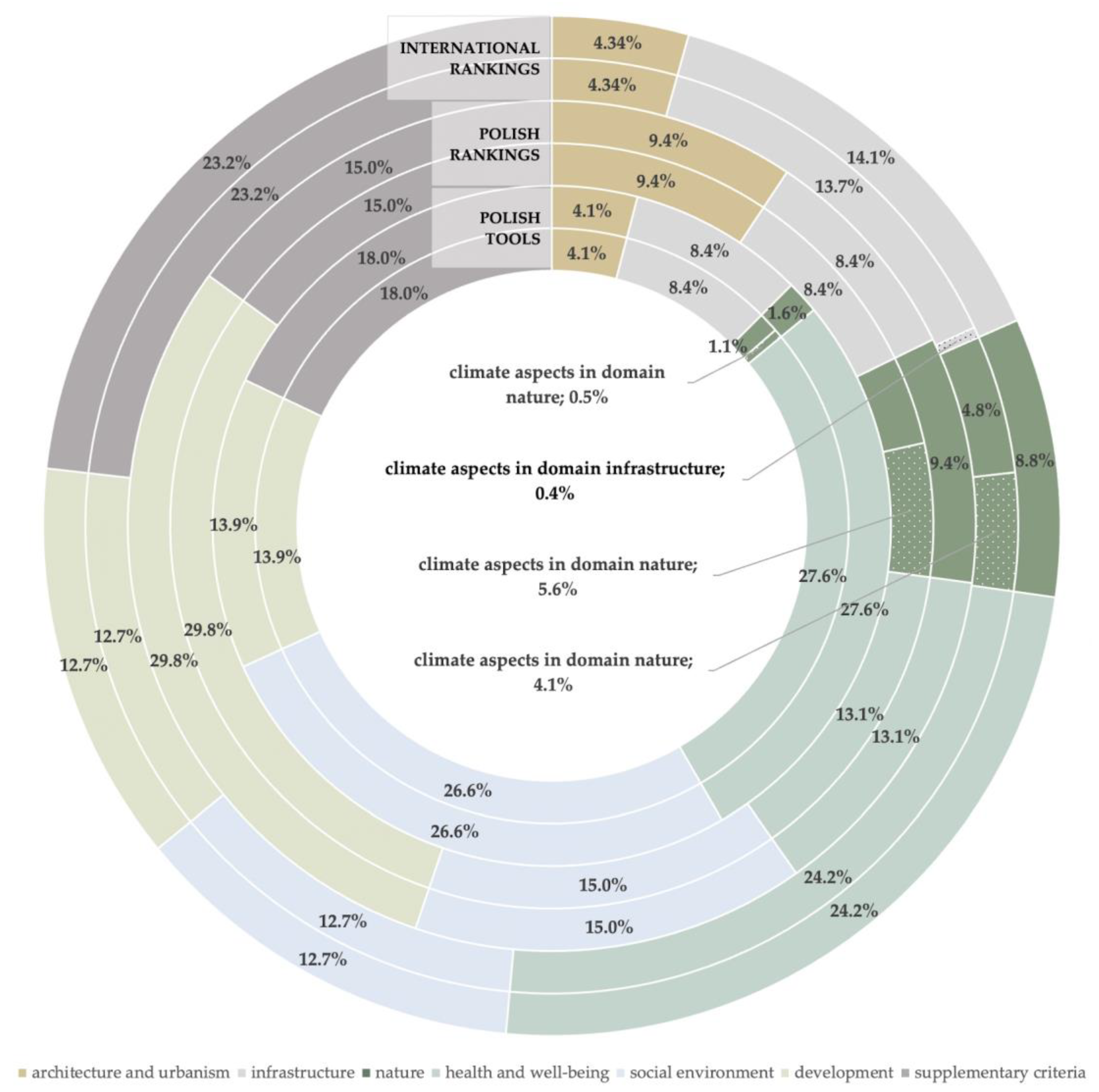

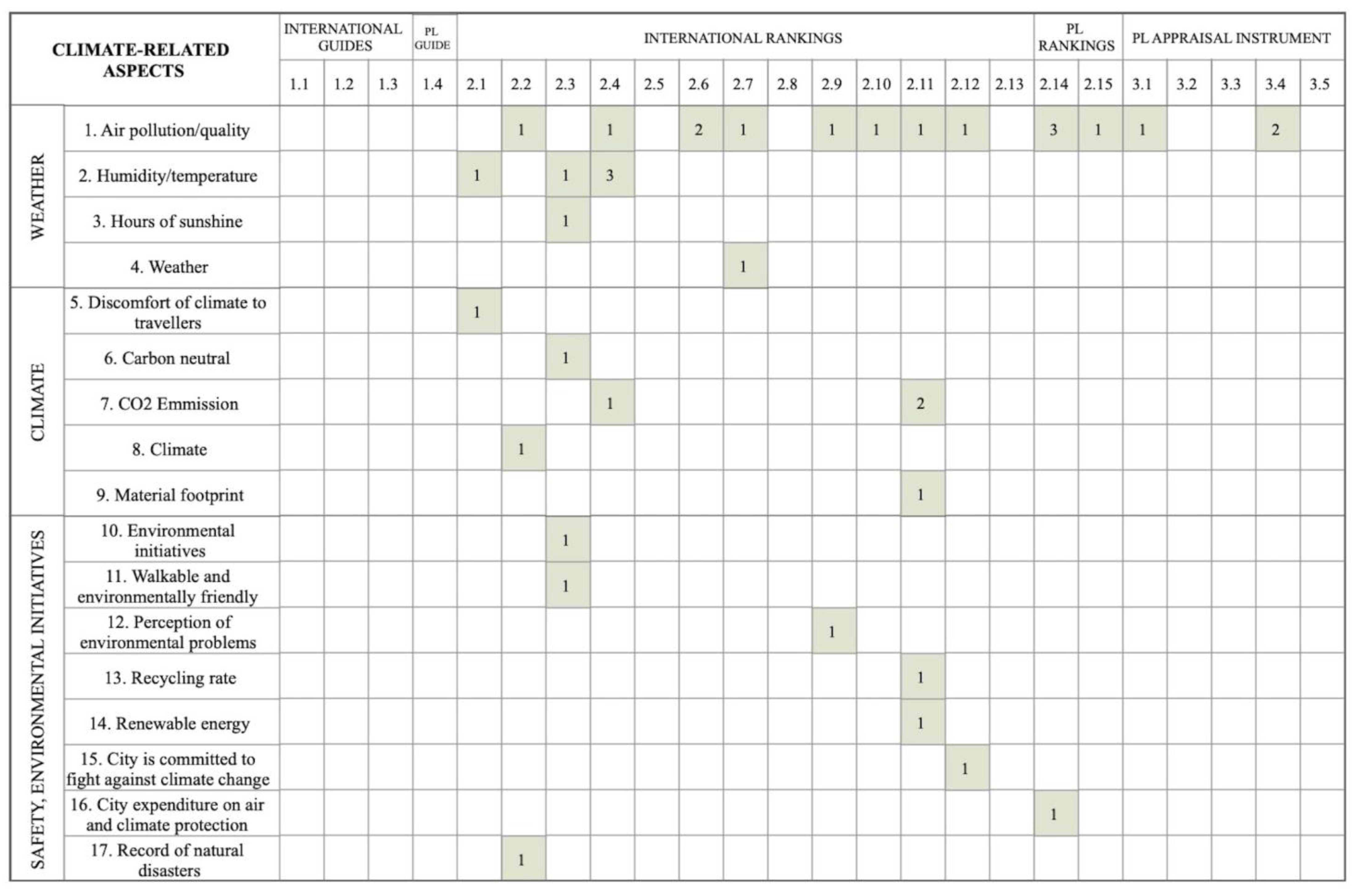
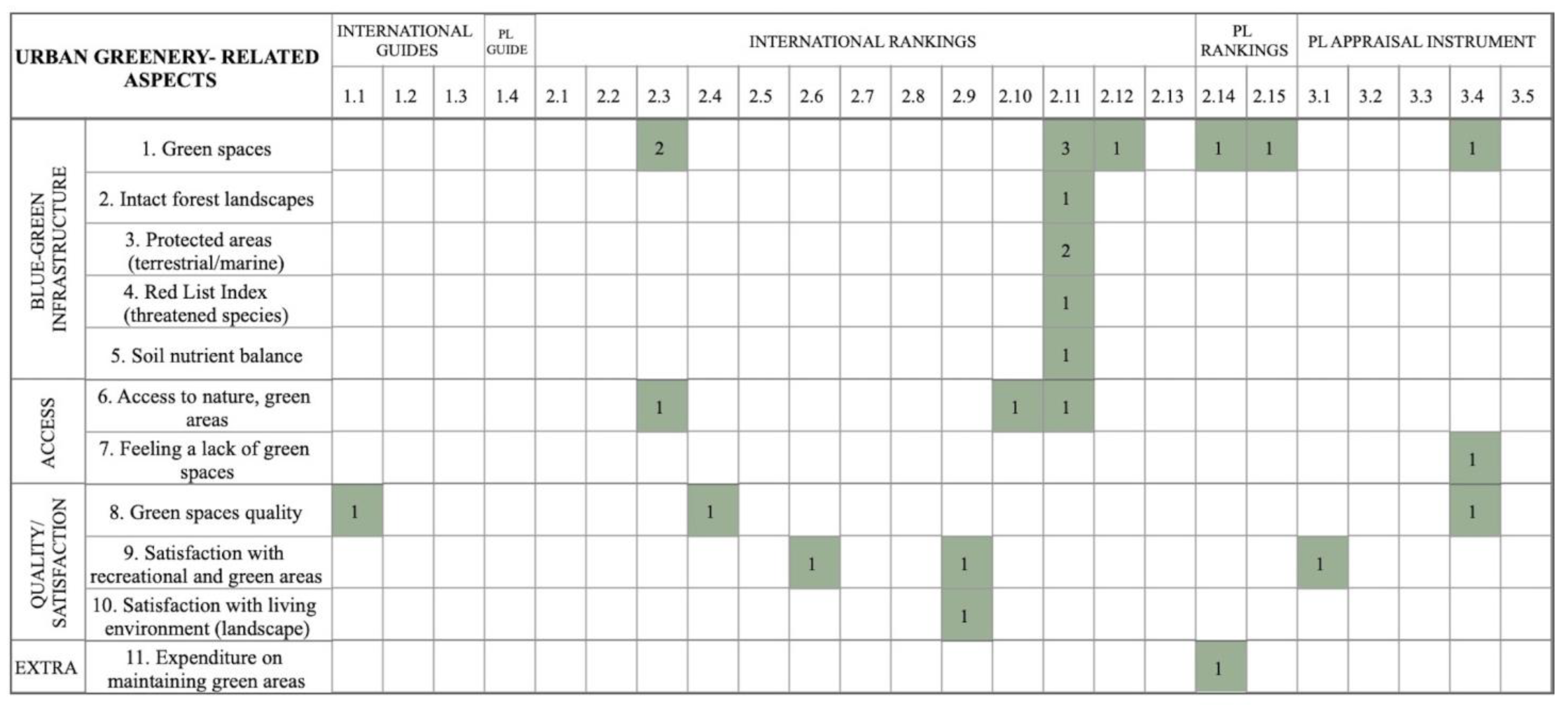
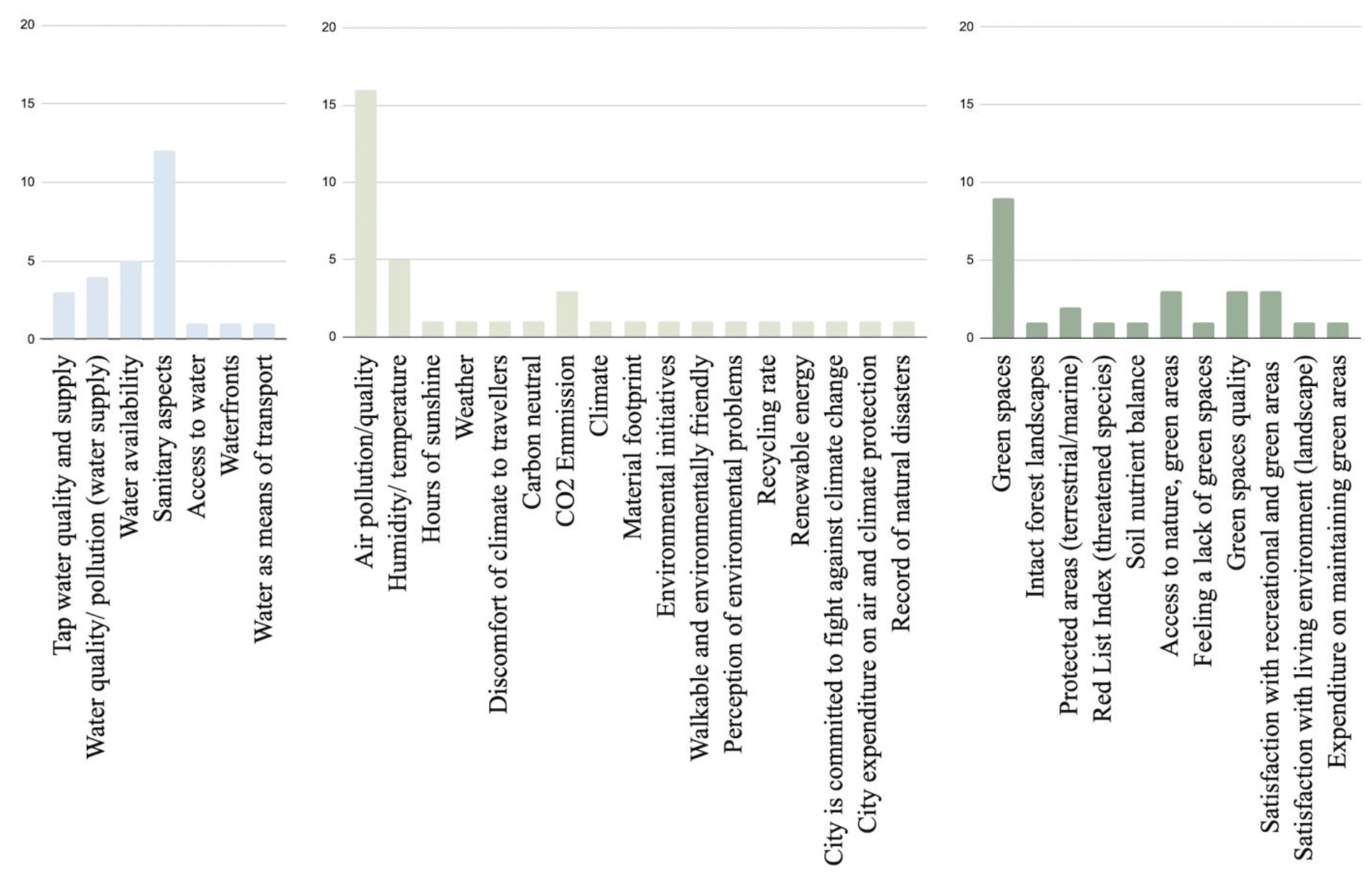
| Type | No. | Name | Institutions |
|---|---|---|---|
| International guides | 1.1 | Global Age-friendly Cities—A Guide [36] | World Health Organization |
| 1.2 | Measuring the age-friendliness of cities. A guide to using core indicators [37] | WHO Kobe Centre | |
| 1.3 | Age-friendly rural and remote communities: a guide [38] | Healthy Aging and Wellness Working Group of the Federal/Provincial/Territorial (F/P/T) Committee of Officials (Seniors) | |
| Polish guide | 1.4 | System wsparcia osób starszych w środowisku zamieszkania—przegląd sytuacji, propozycja modelu. Synteza (System of support for the elderly in the living environment—overview of the situation, model proposal. Synthesis) [39] | Komisja Ekspertów ds. Osób Starszych przy Rzeczniku Praw Obywatelskich |
| International rankings | 2.1 | EIU’s Global Liveability Ranking [40] | The Economist Intelligence Unit (The EIU) |
| 2.2 | Mercer’s Quality of Living Ranking [41] | Mercer LLC | |
| 2.3 | Monocle’s Quality of Living Survey [42] | Monocle | |
| 2.4 | Deutsche Bank Liveability Survey [43](Quality-of-Life Indices) | Deutsche Bank AG/London (data collected from Numbeo) | |
| 2.5 | Euro Health Consumer Index [44] | Health Consumer Powerhouse | |
| 2.6 | IMD Smart City Index [45] | IMD and SUTD (Singapore University for Technology and Design) | |
| 2.7 | Best Cities for Successful Aging [46] | Milken Institute Center for the Future of Aging | |
| 2.8 | Human Development Report [47] | Human Development Report Office | |
| 2.9 | Quality of life (well-being of Europeans) [48] | Directors of Social Statistics Quality of Life Expert Group (EG) | |
| 2.10 | The European Quality of Life Survey (EQLS) [49] | Eurofound | |
| 2.11 | How’s Life? 2020 Measuring Well-being [50] | Household Statistics and Progress Measurement Division of the OECD Statistics and Data Directorate | |
| 2.12 | Quality of life in cities. Perception survey in 79 European cities [51] | European Commission, Directorate-General for Regional and Urban Policy | |
| 2.13 | Active Ageing Index [52] | IRCCS INRCA: National Institute of Health and Science on Ageing, Centre for Socio-Economic Research on Ageing, Ancona, Italy | |
| Polish rankings | 2.14 | Ranking jakości życia. Wymiary szczęścia (Quality of life ranking. Dimensions of happiness) [53] | POLITYKA i Akademia Górniczo- Hutnicza |
| 2.15 | Uciekające metropolie. Ranking 100 polskich miast (Runaway metropolises. Ranking of 100 Polish cities) [54] | Klub Jagielloński | |
| Polish appraisal instruments | 3.1 | Jakość życia w Polsce. Edycja 2017 (Quality of life in Poland. 2017 edition) [55] | Główny Urząd Statystyczny Departament Badań Społecznych i Warunków Życia Departament Analiz i Opracowań Zbiorczych |
| 3.2 | Zadowolenie z życia–CBOS (Life satisfaction–Public Opinion Research Center) [56] | CBOS | |
| 3.3 | Diagnoza społeczna 2015 Warunki i jakość życia Polaków (Social Diagnosis 2015 Objective and Subjective Quality of Life in Poland) [57] | Rada Monitoringu Społecznego | |
| 3.4 | Jakość życia mieszkańców Łodzi i jej przestrzenne zróżnicowanie (Quality of life of Lodz inhabitants and city’s spatial diversity) [58] | Uniwersytet Łódzki, Wydział Ekonomiczno-Socjologiczny, Instytut Socjologii Katedra Socjologii Ogólnej | |
| 3.5 | Jak się żyje osobom starszym w Polsce (How is life for the elderly in Poland) [59] | Główny Urząd Statystyczny |
| Domains and Criteria | Indicators | AV. Weight |
|---|---|---|
| Environment | Green spaces, such as parks and gardens | |
| The quality of the air | 2.63% | |
| The noise level | ||
| Cleanliness | ||
| City is committed to fight against climate change (e.g., energy efficiency, green transport) | 2.63% | |
| The most important issues facing cities | Safety | |
| Air pollution | 2.63% | |
| Noise | ||
| Public transport | ||
| Health services | ||
| Social services | ||
| Education and training | ||
| Unemployment | ||
| Housing | ||
| Road infrastructure | ||
| No. of indicators: 38 | Importance of climate-related indicators in tool | 7.89% |
| QOL Rankings | Sustainable and Resilient Cities Rankings | ||||||||||||
|---|---|---|---|---|---|---|---|---|---|---|---|---|---|
| Mercer’s Quality of Living Ranking [41] | Monocle’s Quality of Life Survey [42] | Deustche Bank Liveability Survey [43] | Arcadis Sustainable Cities Water Index [30] | Arcadis Sustainable Cities Index [63] | Grosvenor Group Resilient Cities [64] | Global Ranking of Top 10 Resilient Cities [65] | |||||||
| City | City | City | City | City | City | City | |||||||
| 1 | Vienna | 1 | Zurich | 1 | Zurich | 1 | Rotterdam | 1 | London | 1 | Toronto | 1 | Copenhagen |
| 2 | Zurich | 2 | Tokyo | 2 | Wellington | 2 | Copenhagen | 2 | Stockholm | 2 | Vancouver | 2 | Curitiba |
| 3 | Vancouver | 3 | Munich | 3 | Copenhagen | 3 | Amsterdam | 3 | Edinburgh | 3 | Calgary | 3 | Barcelona |
| 3 | Munich | 4 | Copenhagen | 4 | Edinburgh | 4 | Berlin | 4 | Singapore | 4 | Chicago | 4 | Stockholm |
| 3 | Auckland | 5 | Vienna | 5 | Vienna | 5 | Brussels | 5 | Vienna | 5 | Pittsburg | 5 | Vancouver |
| 6 | Dusseldorf | 6 | Helsinki | 6 | Helsinki | 6 | Toronto | 6 | Zurich | 6 | Stockholm | 6 | Paris |
| 7 | Frankfurt | 7 | Hamburg | 7 | Melbourne | 7 | Frankfurt | 7 | Munich | 7 | Boston | 7 | San Francisco |
| 8 | Copenhagen | 8 | Madrid | 8 | Boston | 8 | Sydney | 8 | Oslo | 8 | Zurich | 8 | New York |
| 9 | Geneva | 9 | Berlin | 9 | San Francisco | 9 | Birmingham | 9 | Hong Kong | 9 | Washington DC | 9 | London |
| 10 | Basel | 10 | Lisbon | 10 | Sydney | 10 | Manchester | 10 | Frankfurt | 10 | Atlanta | 10 | Tokyo |
Publisher’s Note: MDPI stays neutral with regard to jurisdictional claims in published maps and institutional affiliations. |
© 2021 by the authors. Licensee MDPI, Basel, Switzerland. This article is an open access article distributed under the terms and conditions of the Creative Commons Attribution (CC BY) license (https://creativecommons.org/licenses/by/4.0/).
Share and Cite
Ptak-Wojciechowska, A.; Januchta-Szostak, A.; Gawlak, A.; Matuszewska, M. The Importance of Water and Climate-Related Aspects in the Quality of Urban Life Assessment. Sustainability 2021, 13, 6573. https://doi.org/10.3390/su13126573
Ptak-Wojciechowska A, Januchta-Szostak A, Gawlak A, Matuszewska M. The Importance of Water and Climate-Related Aspects in the Quality of Urban Life Assessment. Sustainability. 2021; 13(12):6573. https://doi.org/10.3390/su13126573
Chicago/Turabian StylePtak-Wojciechowska, Agnieszka, Anna Januchta-Szostak, Agata Gawlak, and Magda Matuszewska. 2021. "The Importance of Water and Climate-Related Aspects in the Quality of Urban Life Assessment" Sustainability 13, no. 12: 6573. https://doi.org/10.3390/su13126573
APA StylePtak-Wojciechowska, A., Januchta-Szostak, A., Gawlak, A., & Matuszewska, M. (2021). The Importance of Water and Climate-Related Aspects in the Quality of Urban Life Assessment. Sustainability, 13(12), 6573. https://doi.org/10.3390/su13126573








